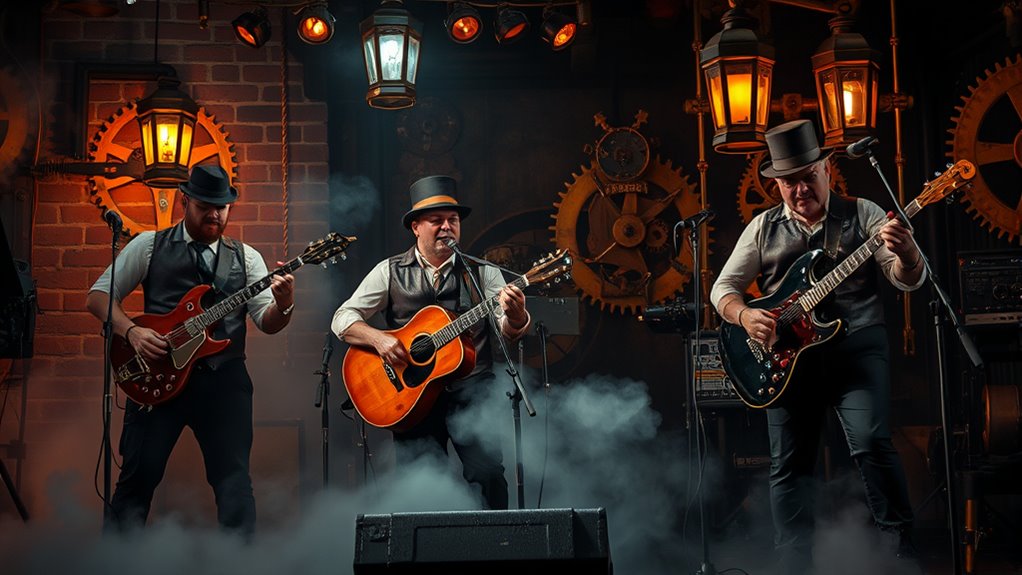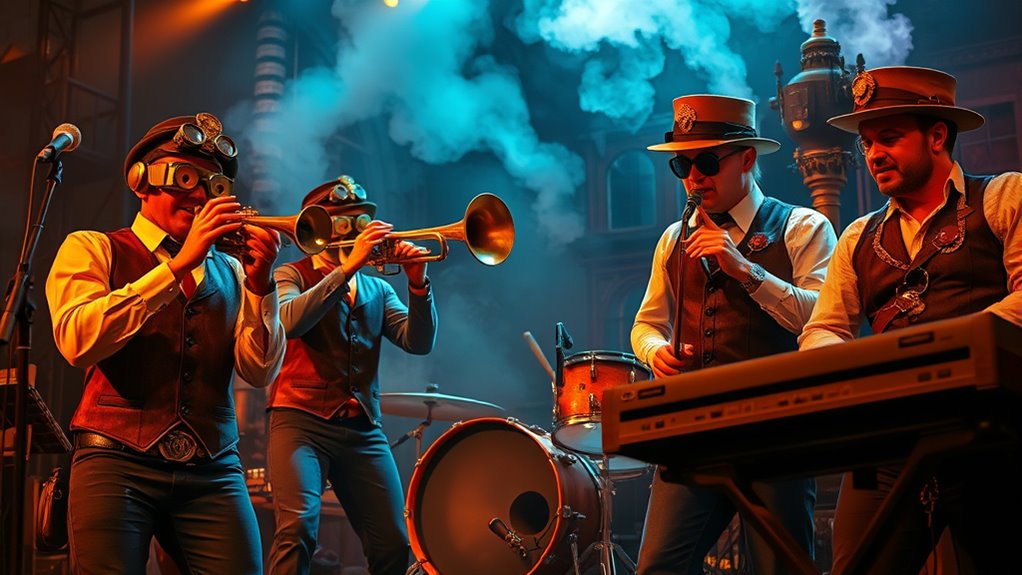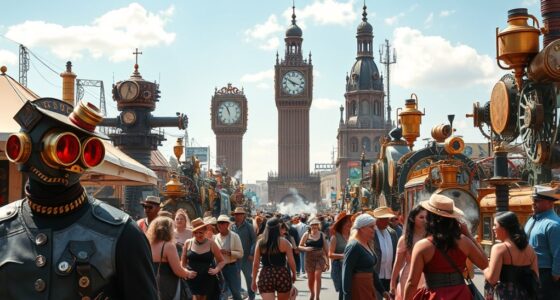Steampunk music blends Victorian elegance with industrial sounds, creating an immersive mix of vintage machinery, brass gears, and storytelling. You’ll hear bands that combine ornate melodies with gritty metal clanking, transport you to a world of invention and rebellion, and evoke a nostalgic yet futuristic vibe. Highlights include artists inspired by steam-powered visuals and craftsmanship, crafting a unique sonic universe. Stay curious, because there’s much more to discover about this fascinating genre and its creative bands.
Key Takeaways
- Steampunk music blends Victorian elegance with industrial sounds like metal clanking and gears for a unique, dystopian aesthetic.
- Bands such as Abney Park, The Cog is Dead, and Steam Powered Giraffe are prominent examples in the genre.
- The genre emphasizes storytelling, often exploring themes of invention, rebellion, and adventure through theatrical vocals.
- Artists incorporate vintage instruments, synths, and industrial noises to create layered, immersive soundscapes.
- Steampunk music celebrates craftsmanship and imagination, offering an immersive experience where past and future collide.

Have you ever wondered what it sounds like when Victorian-era aesthetics meet modern music? Steampunk music is exactly that fusion, blending the elegance and intricate details of Victorian aesthetics with the raw, mechanical energy of industrial sounds. This genre immerses you in a world where brass gears turn, steam hisses, and vintage machinery influences every beat. As you listen, you might imagine yourself stepping into a steampunk cityscape, where ornate clockwork contraptions and Victorian fashion coexist with pulsating rhythms. The aesthetic isn’t just visual; it’s woven into the very fabric of the music, creating a unique auditory experience that transports you to an alternate past fused with futuristic imagination.
Step into a Victorian-inspired world where steam and gears pulse through modern melodies.
In steampunk music, Victorian aesthetics serve as a foundation, inspiring both the instrumentation and the thematic elements. You’ll often hear melodies that evoke the grandeur and ornate elegance of the 19th century, but with a twist—incorporating industrial sounds like clanking metal, grinding gears, and steam-powered machinery. These sounds aren’t just background noise; they’re integral to the composition, adding grit and texture that give the music a mechanical, almost dystopian feel. This combination results in a soundscape that feels both nostalgic and innovative, as if you’re listening to a Victorian inventor’s experimental symphony. It’s a genre that celebrates craftsmanship—meticulous, detailed, and a little bit rebellious against modern digital perfection.
Many bands and artists harness this aesthetic and sound palette to craft their identity. They often use vintage instruments or synthesize industrial noises to produce a rich, layered sound. The vocals tend to be theatrical or reminiscent of Victorian ballads, adding a sense of storytelling and drama. It’s common to encounter lyrics that evoke steampunk themes—adventure, exploration, invention, and rebellion—further immersing you in this hybrid universe. The genre’s appeal lies in its ability to combine the elegance of Victorian design with the gritty, mechanical energy of industrial sounds, creating a sonic world that’s both nostalgic and forward-looking. Additionally, some artists incorporate influences from Art News & Views, blending visual art inspiration with their musical narratives.
Ultimately, steampunk music invites you to experience a world where Victorian aesthetics and industrial sounds collide, forging a distinct musical landscape. It’s not just about listening; it’s about feeling transported into a universe where the past and future intertwine through sound. Whether you’re drawn to the ornate melodies or the mechanical rhythms, this genre offers a compelling escape—an auditory adventure that celebrates innovation, craftsmanship, and imagination.
Frequently Asked Questions
How Did Steampunk Music Originate Historically?
You might notice that steampunk music originated during the late 20th century, drawing heavily on Victorian musical influences and the Industrial Revolution sounds. As enthusiasts combined these historical elements with modern technology, they created a unique genre that evokes the era of steam-powered innovation. You’ll find that the music often features mechanical rhythms, vintage instruments, and a nostalgic yet futuristic vibe, reflecting both history and imagination in a enthralling way.
What Are the Key Musical Instruments Used in Steampunk Bands?
You’ll find Victorian-era instruments like brass horns, accordions, and violins in steampunk bands, blending old-world charm with modern flair. Mechanical sound effects, such as gears turning or steam hissings, add a futuristic twist. These instruments and effects create a unique soundscape that transports you to a bygone era with a steampunk twist, making each performance both nostalgic and innovative. It’s a mesmerizing mix that defines the genre’s musical identity.
Are There Specific Fashion Elements Associated With Steampunk Music Performances?
When you attend a steampunk music performance, you’ll notice the fashion elements stand out. Victorian-inspired costumes set the tone, featuring corsets, waistcoats, and flowing skirts. Goggles and intricate accessories add a mechanical touch, emphasizing the retro-futuristic vibe. You might also see gears, pocket watches, and brass details. These elements create a mesmerizing visual experience, perfectly complementing the inventive, eclectic spirit of the music.
How Has Steampunk Music Influenced Mainstream Genres?
You’ll notice steampunk music’s influence in mainstream genres through exciting fusion genres and modern adaptations. It blends Victorian-inspired aesthetics with contemporary sounds, inspiring artists to experiment with steampunk themes in genres like rock, electronic, and indie. This crossover sparks creativity, making steampunk elements more accessible and widely appreciated, ultimately shaping a unique, eclectic style that resonates across diverse musical landscapes.
Where Can I Find Steampunk-Themed Music Festivals or Events?
Like a clockwork dance, you can find steampunk-themed festivals at various steampunk festival venues and underground event spaces. Check out dedicated websites, social media groups, or event platforms like Eventbrite for upcoming gatherings. Major steampunk festivals often take place in historic cities or creative hubs, offering immersive experiences. Keep an eye on local arts calendars and steampunk communities online—they’re your map to discovering these unique, gear-laden adventures.
Conclusion
As you delve into steampunk music and bands, you’re exploring a vibrant tapestry woven from Victorian elegance and industrial grit. Think of it as a clockwork universe, each gear and cog working in harmony to create a rich, immersive experience. Embrace the genre’s creativity and innovation, allowing yourself to be carried away by its steampunk symphony—an intricate dance where past and future collide, revealing a world as enthralling and complex as a finely crafted timepiece.









